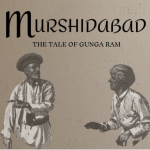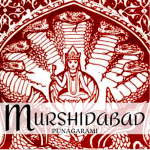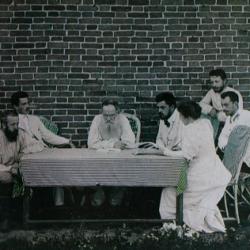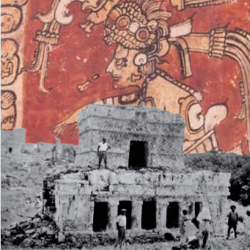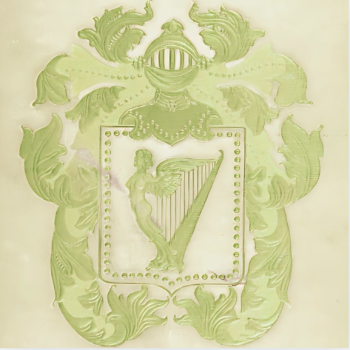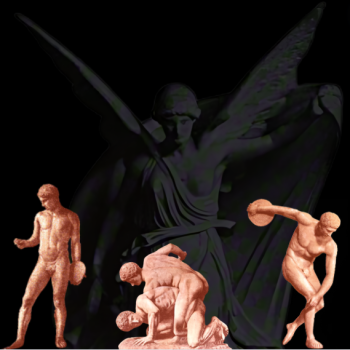MEMORIAL TREE
May 31, 1889, marked the end of Ramadan, and the great celebration of Eid al-Fitr. After which the Nawab spent the better part of June at the Dalhousie Institute in Calcutta, in an effort to restore his health.[1] Between “routine work” and studying Hindi, Bengali, and Russian, Johnston’s time was “pretty well filled up.” [2] His aptitude at Russian had advanced enough that he was undertaking a translation Vera Petrovna’s new children’s book, Rosanchik, which was published in Russia earlier that year.[3]
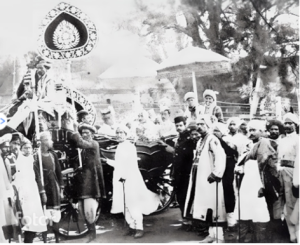
The Eid Procession.[4]
Johnston was probably made aware of a correspondence by his father which appeared in the May 7, 1889, issue of The Evening Standard, in which Ballykilbeg asked that paper to record a “strange fact” concerning the “Memorial Trees” that marked the centenary of the French Revolution.[5] William Johnston’s letter was about his parents, John and Thomasina, and two Lombardy Poplars which were planted in Ballykilbeg, after their marriage, in 1823.[6] He writes: “They grew side by side, and were tall and beautiful, until 1852 and 1853. In those years, my mother first, and then my father, died; and the Poplars, one in 1852 and the other the next year, ceased to exist.”[7] An article particularly strange indeed for the elder Johnston who considered even vegetarianism “a strange mixture of diet and diablism.”[8]
It is curious to note that Kali Prasanna Mukerji, the Secretary of Adhi Bhoutic Bhratri, sent a letter to The Theosophist around this time, discussing a similar topic, and it is not inconceivable that the conversation had its genesis through a discussion with Johnston. Mukerji’s letter was about an Ojah, a kind of “village sorcerer,” who, through trickery, turned the spirit of a Brahmin into a Bhoot (ghost) and tethered it to a tree.[9] He learned the story from Pundit Keshava Chandra Bhuttacharya, a very active and earnest member of the Berhampore Branch. In 1889 Bhuttacharya and fellow member, Nafar Das Roy, opened three clubs in Murshidabad (Gorabazar, Berhampore, and Sydabad) to explain Theosophy to outsiders and new members who felt inconvenienced by attending Branch meetings. It was due to the efforts of these two men that the owing to the exertions of the above two brothers that the Jaina Branch at Balucher was formed.[10]
Not all Ojah were wicked. Johnston would likely have been aware of Nitai Charan Mukherji, a noted Ojah in the Kandi Subdivision who was renowned for his ability to cure snake bites. He would cut a jute plant on an auspicious day, and make a string from its fibers, which was tied to the victim; around the finger if bitten above the waist, around the toe if below the waist. Mantras were chanted, and the poison, which accumulated at the tips of the tied digit. The finger or toe would then be cut, and the poison would secrete like “coal tar.” After recovery, this “quintessence” was given as an offering to Manasa Devi, the goddess of the serpent-race, and when a snake appeared in a house, milk and rice were offered to the god Nag.[11]
← Table Of Contents →
SOURCES:
[1] “The Nawab Of Murshidabad.” The Englishman’s Overland Mail. (Calcutta, India) July 6, 1889.
[2] Guinness, Selina, “Ireland Through The Stereoscope: Reading The Cultural Politics Of Theosophy In The Irish Literary Revival” in Betsey Taylor FitzSimon and James H. Murphy (ed.,) The Irish Revival Reappraised. Four Courts Press. Dublin, Ireland (2004): 19-32.
[3] [Zhelihovskaya, Vera Petrovna. Rosanchik. Izdanie A. F. Devriena. Saint Petersburg, Russia. (1889); Johnston.] Based on the contents of some of Vera’s letters, we might conclude that Johnston was the uncredited translator for the 1894 English translation of Rosanchik, titled Rosy Mite. Vera writes: “Charley sits next to me translating Rosanchik. I’m tired of stupid India—it’s worse than a bitter radish.” [V. V. “Letters of Vera Johnston,” January 19, 1890 [g.,] Kandi , India, entry.] In a letter to Vera Petrovna, Johnston writes: “I’ll finish the translation now. I hope it well be translated well enough; Vera likes it.” [V. V. “Letters of Vera Johnston,” February 25, 1890 [g.,] Kandi, India, entry.] In late August 1894 Faulding decided to publish “Rosanchik.” Truslove and Hanson would print 300 copies for the Christmas season, with the potential for more editions. Vera and Charley would receive nothing for the first thousand, and 10% for the second. “The conditions are good,” Vera states, “as the company is businesslike, and assures us that it will sell at least 2,500 copies.” The publishers wanted to sell Rosanchik for 2 shillings and 6 pence. To reduce the cost of printing, the size of the book was reduced, and the illustrations were colorless. Truslove and Hanson also decided that it would be unwise to mention that it was a translation from Russian, and to let readers “think it [was originally] written in English.” [V. V. “Letters of Vera Johnston,” [August 27, 1894 [g.,] 17 Avenue Road, London, England, entry.] Rosanchik would be published in English under the title “Rosy Mite,” and hit the shelves in time for Christmas 1894. [Zhelihovskaya, Vera Petrovna. Rosy Mite or The Witch’s Spell. Truslove And Hanson. London, England. (1894)] A review in Lucifer for “Rosy Mite” states: “Such a kindly spirit of good fellowship with all that lives speaks throughout the pages of this dainty little story, that no child–old or young–can follow the Rosy Mite’s adventures amongst the insect folk without feeling the better for having read about them. Her unconscious doing of the three great deeds, by which right conquers might and the witch’s spell is broken, is charmingly told.” [H.T.E. “Review: Rosy Mite: Or The Witch’s Spell.” Lucifer. Vol. XV, No. 87. (November 15, 1894): 252.]
[4] Majumdar, Purna Chundra. The Musnud Of Murshidabad (1704-1904): Being A Synopsis Of The History Of Murshidabad For The Last Two Centuries. Saroda Ray. Murshidabad, India. (1905): 132.
[5] “London, Tuesday, May 7.” The Evening Standard. (London, England) May 7, 1889.
[6] Walford, Edward. The County Families Of The United Kingdom Or Royal Manual Of The Titled And Untitled Aristocracy Of Great Britain And Ireland. Chatto & Windus. London, England. (1893): 559.
[7] Johnston, W. M. “Memorial Trees.” The Standard. (London, England) May 8, 1889. This story was recounted in the July, 1889, Supplement To The Theosophist. see “Strange Sympathy.” Supplement To The Theosophist. Vol. X. (July, 1889): cxxvii.
[8] In a note from July, 1889, William Johnston writes: “I have looked at the Vegetarian with a desire to see reasons in favor of the diet recommended; and I have seen its columns advocate socialism and Theosophy. I see a tendency, also, to disparage the Great Sacrifice…while this is so, I cannot embrace Vegetarianism. Rather I would shun it as Anti-Christian. I believe in Christ; and sooner than give up this faith, which is so made made incompatible with the teachings of this new creed, I will antagonize, and not advocate, the strange mixture of diet and diablism.” see Guinness, Selina, “Ireland Through The Stereoscope: Reading The Cultural Politics Of Theosophy In The Irish Literary Revival” in Betsey Taylor FitzSimon and James H. Murphy (ed.,) The Irish Revival Reappraised. Four Courts Press. Dublin, Ireland (2004): 19-32.
[9] A. K. “Psychic Notes.” The Theosophist. Vol. X, No. 119 (August 1889): 693-695.
[10] Mukherji, K.P. “A Good Move.” Supplement To The Theosophist. Vol. XI. (December 1889): xivi.
[11] Walsh, J.H. Tull. A History Of Murshidabad District (Bengal): With Biographies Of Some Of Its Noted Families. Jarrold & Sons. London, England. (1902): 62, 83.


